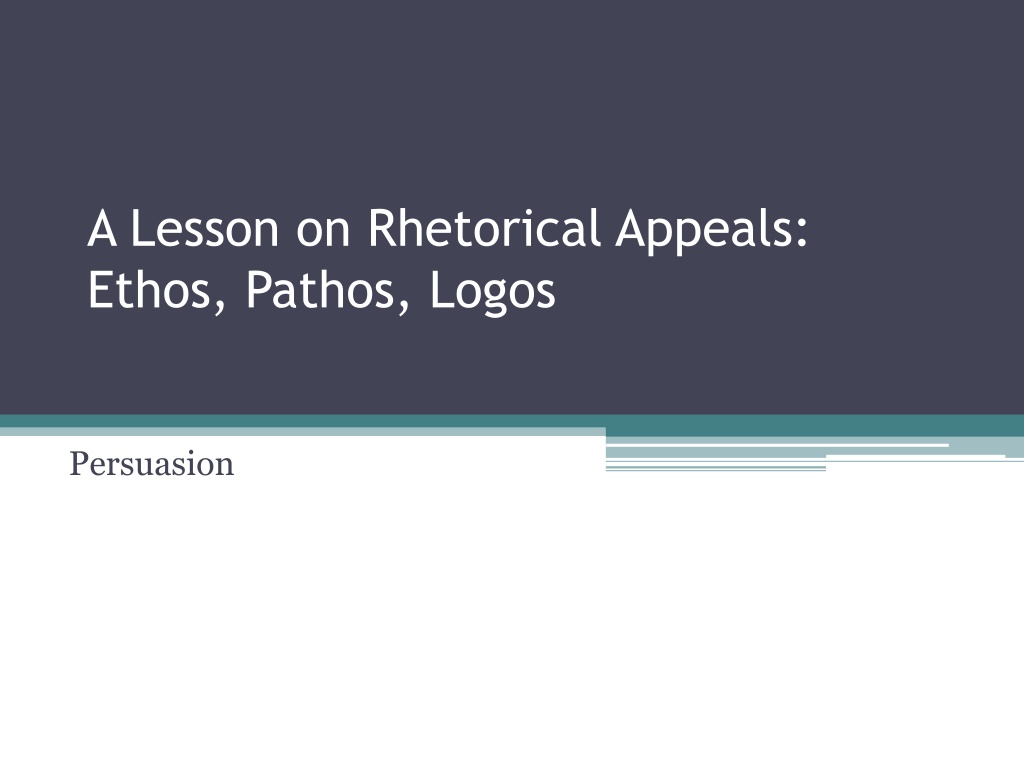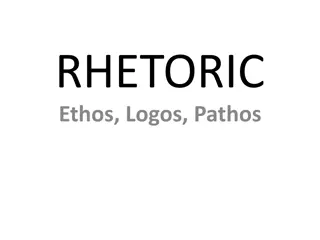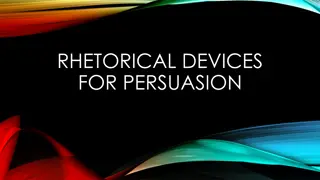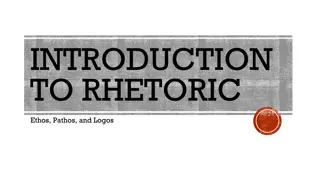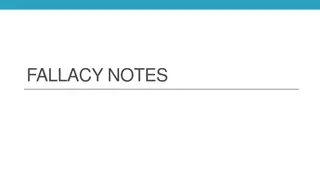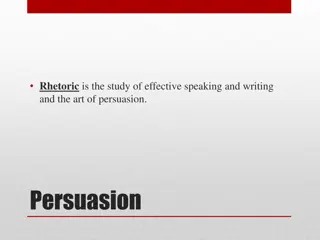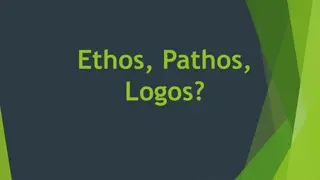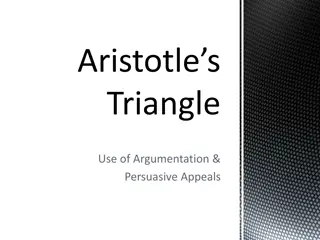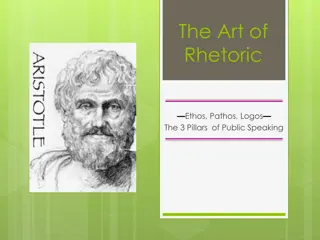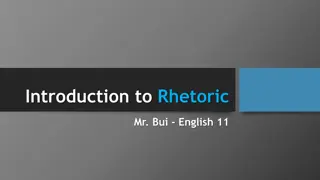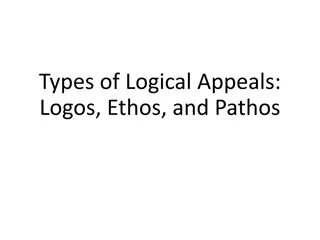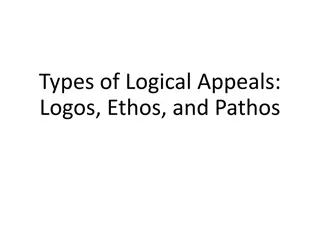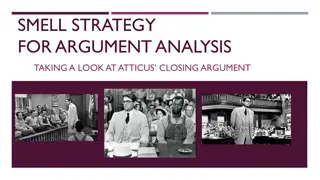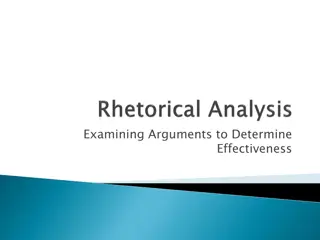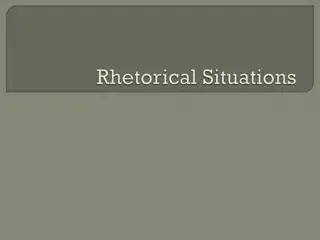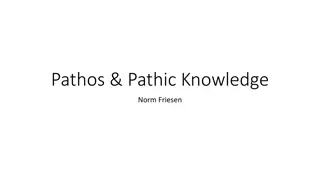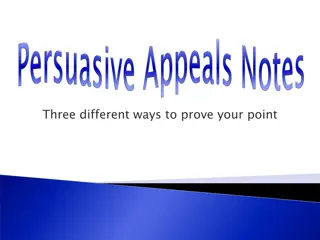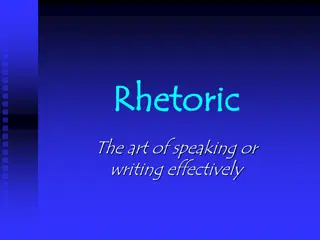Understanding Rhetorical Appeals: Ethos, Pathos, Logos
Delve into the art of persuasive communication through the exploration of ethos, pathos, and logos appeals. Discover how these rhetorical tools are utilized to sway audiences' emotions, logic, and credibility. Gain insights on how to analyze and decipher persuasive techniques employed by writers, speakers, and advertisers to enhance critical thinking skills.
Download Presentation

Please find below an Image/Link to download the presentation.
The content on the website is provided AS IS for your information and personal use only. It may not be sold, licensed, or shared on other websites without obtaining consent from the author. Download presentation by click this link. If you encounter any issues during the download, it is possible that the publisher has removed the file from their server.
E N D
Presentation Transcript
A Lesson on Rhetorical Appeals: Ethos, Pathos, Logos Persuasion
Critical reading - Intro. As we become more critical readers we can use the knowledge of rhetorical appeals to analyze how an author is trying to persuade us.
Rhetoric Rhetoric is the art and skill of effective persuasive speaking and writing. Aristotle developed the Triangle of Rhetoric. You will study the three rhetorical appeals this quarter. We will connect other specific elements of argument (evidence, fallacies, etc.) back to the rhetorical appeals. You will likely encounter them in high school English and in college classes.
Basic Definitions Appeal= the overall approach a writer/speaker uses to persuade an audience. Pathos= an appeal to the audience's emotions. Logos= an appeal to the audience's logic/reasoning. Ethos= an appeal to the audience s sense of .
Why is it important for me to understand these three terms?(box on right) Writers, artists, speakers, and advertisers use these appeals to persuade you all the time. In order to be a critical reader/thinker, you must be able to detect these appeals and how they impact your beliefs and actions.
Three Forms of Rhetoric Ethos Logos Pathos
Ethos (Character & Credibility) Ethos: Appeal to our desire that the speaker/writer be an ethical person the source's credibility, the speaker's/author's authority Why it Works: We tend to believe people that we respect, trust, and like. Reader Response: I like and trust this person. He really seems like he knows what he is talking about, and I don t think he would be dishonest.
Ethos Strategies Make the reader respect you. One strategy: Admit that you do not know everything or that you can t magically make everything better. I don t have all the answers. I ve made my share of mistakes. Make the reader like your character or personality. One strategy: Using humor to increase your likability and reliability. Make the reader trust and believe you. Emphasizing your training and/or you direct experience with the topic. Ex. I ve been teaching for 10 years Ex. I m not a professional mechanic, but I ve worked on cars in my spare time for years. That sounds to me like the timing belt is loose. Ex. Emphasize the ways you and your audience are similar. (Background, concerns, etc.) Use vocabulary and grammar appropriate to your audience. Ex:. Speaking casually with your peers, and formally with your boss or grandparents.
Ethos Example: Product: George Foreman and his Grilling Machine Credentials: Boxing Champ and a Preacher Do these ads rely more on Foreman s credibility (his expertise on grilling and small appliances) or on character (he has a good reputation as a preacher and a famous athlete, he wouldn t be dishonest)? What is another example of a person using ethos to increase the appeal of their argument?
Logos (Logical) Appeal to Logic Logos: persuasion by the use of reasoning Why It Works: It makes the reader think about facts, reasons, causes and effects, etc. It establishes a conclusion that is more difficult to dismiss as silly or refute as wrong. Reader Response: That makes a lot of sense; it is hard to argue against that.
Logos Strategies Clear and logical reasons to support claim. Provides a variety of evidence such as: Factual data and statistics Expert informed opinions Makes the reader rationally question a belief. Use mostly neutral language so there is no distraction from the reasonability of the argument.
Logos Example: Idea: Senior privilege should be expanded to include juniors because _______________. List three reasonable supporting reasons, facts and/or statistics that will support the this claim. Your audience is Mr. Olson, Mrs. Hogen, Mr. Nemenich, and Mr. Bain.
Pathos This is an appeal to emotions or feelings. It can appeal to higher emotions or lower emotions. Why it Works: Emotions of fear, love, hope, etc. are extremely powerful and shape decisions we make everyday. It draws a personal connection between the readers experience and the issue at hand. Reader Response: I am connected to this issue because _________. It makes me happy/sad/angry/ worried/ etc. about it. What can I do?
Pathos Strategies Loaded, Emotionally-charged language (positive or negative connotations) Personal narratives (anecdotes) of emotional events Vivid description Makes the reader feel a particular emotion. (The advertisements for a product make you feel happy, so you come to connect happiness with the product. That little connection can be enough to make you pick it up instead of the competing product when you are choosing at the store.)
Pathos Example: How does this advertisement appeal to emotion? Why?
Now, you try it! Matching 1. Homicide, robbery and arrest rates in 2005 were actually lower than they were in 2003. 2. This is no time to let down our guard on community violence," Dr. Satcher said. "Even so, our recent success in developing knowledge and tools to prevent serious violence gives us reason for optimism. 3. Dr. Satcher, the Surgeon General for the United States, has written an article examining community violence. _______ ethos ______logos _____pathos
Both of these pictures represent the same model and actress, Rebecca Romijn. How does each ad shape Ethos differently? Why would the creators choose to do that? At what age and stage of life would a woman best relate to each ad?
Ethos? Logos? Pathos? There s a lot of misinformation out there about sugars made from corn. Truth is, high fructose corn syrup is nutritionally the same as table sugar. The same number of calories, too. As registered dietitians recommend, keep enjoying the foods you love, just do it in moderation. We welcome a healthy discussion. Get the facts. You re in for a sweet surprise. ---American Corn Refiners Association Click Image to Open a Larger Version
Ethos? Logos? Pathos? World Wildlife Fund w
Ethos? Logos? Pathos?
Ethos? Logos? Pathos? http://www.youtube.com/watch?v=7OIEFo2axGE
Ethos? Logos? Pathos? The Nissan LEAF. 100% electric. Nissan introduces the LEAF, a battery-powered four-door hatchback with a range of 100 miles and a top speed of 87 miles an hour.
